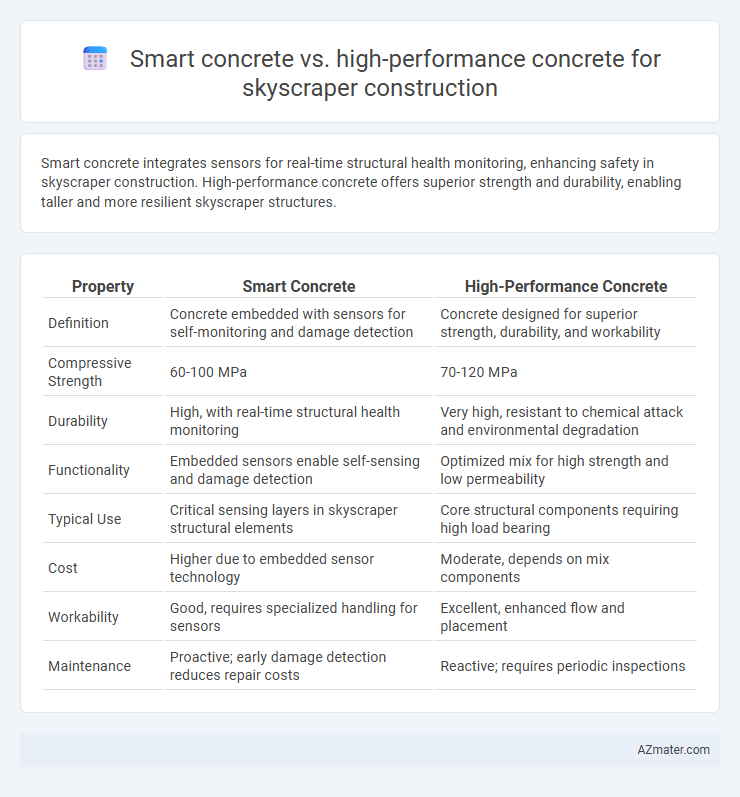Smart concrete integrates sensors for real-time structural health monitoring, enhancing safety in skyscraper construction. High-performance concrete offers superior strength and durability, enabling taller and more resilient skyscraper structures.
Table of Comparison
| Property | Smart Concrete | High-Performance Concrete |
|---|---|---|
| Definition | Concrete embedded with sensors for self-monitoring and damage detection | Concrete designed for superior strength, durability, and workability |
| Compressive Strength | 60-100 MPa | 70-120 MPa |
| Durability | High, with real-time structural health monitoring | Very high, resistant to chemical attack and environmental degradation |
| Functionality | Embedded sensors enable self-sensing and damage detection | Optimized mix for high strength and low permeability |
| Typical Use | Critical sensing layers in skyscraper structural elements | Core structural components requiring high load bearing |
| Cost | Higher due to embedded sensor technology | Moderate, depends on mix components |
| Workability | Good, requires specialized handling for sensors | Excellent, enhanced flow and placement |
| Maintenance | Proactive; early damage detection reduces repair costs | Reactive; requires periodic inspections |
Introduction to Modern Concrete Technologies in Skyscraper Construction
Smart concrete integrates sensors and self-healing properties to enhance durability and monitor structural health in skyscraper construction, offering real-time data for maintenance and safety. High-performance concrete (HPC) focuses on superior mechanical properties such as increased strength, reduced permeability, and improved workability, which are critical for the load-bearing requirements and longevity of tall buildings. Both technologies represent advancements in modern concrete materials, optimizing skyscraper construction through improved resilience and performance.
Defining Smart Concrete: Innovations and Capabilities
Smart concrete integrates embedded sensors and self-healing properties that enable real-time structural health monitoring and damage mitigation, enhancing longevity and safety in skyscraper construction. Its capabilities include strain sensing, temperature monitoring, and crack detection, providing continuous data to engineers for proactive maintenance. Compared to high-performance concrete, which emphasizes strength, durability, and workability through optimized mix designs, smart concrete prioritizes adaptability and intelligence in infrastructure management.
Understanding High-Performance Concrete: Key Characteristics
High-performance concrete (HPC) is distinguished by its superior strength, durability, and advanced mix design incorporating additives like silica fume and superplasticizers, resulting in enhanced compressive strength exceeding 50 MPa. Its low permeability makes HPC ideal for skyscrapers by resisting environmental stressors such as freeze-thaw cycles, chemical attacks, and corrosion of reinforcing steel. Compared to smart concrete, which integrates sensors for structural health monitoring, HPC primarily focuses on mechanical and durability performance crucial for the long-term integrity of tall building structures.
Structural Requirements of Skyscrapers: Concrete Needs
Smart concrete offers self-sensing capabilities that enable real-time structural health monitoring, essential for skyscrapers subjected to dynamic loads like wind and seismic activity. High-performance concrete provides exceptional strength, durability, and reduced permeability, meeting the critical structural requirements to support towering loads and resist environmental degradation. Both materials fulfill essential concrete needs in skyscraper construction, with smart concrete enhancing safety through monitoring and high-performance concrete ensuring foundational resilience.
Strength and Durability: Smart vs High-Performance Concrete
Smart concrete integrates advanced materials like nanomaterials or embedded sensors, enhancing real-time structural health monitoring while maintaining high strength and adaptability to environmental stresses. High-performance concrete (HPC) exhibits exceptional compressive strength, often exceeding 70 MPa, with superior durability against chemical attack, freeze-thaw cycles, and abrasion, making it ideal for load-bearing skyscraper frameworks. While HPC primarily focuses on maximizing mechanical properties and longevity, smart concrete offers dynamic durability by enabling proactive maintenance through continuous performance data collection.
Integration of Sensors and Monitoring in Smart Concrete
Smart concrete integrates embedded sensors that enable real-time monitoring of structural health, detecting stress, cracks, and temperature variations within skyscraper frameworks. This sensor integration allows for proactive maintenance, enhancing safety and extending the lifespan of high-rise buildings compared to traditional high-performance concrete. High-performance concrete emphasizes strength and durability but lacks the embedded technological capabilities that make smart concrete a superior choice for advanced structural monitoring.
Workability and Construction Efficiency Comparison
Smart concrete enhances workability through self-sensing and self-healing properties, reducing the need for extensive manual inspections during skyscraper construction. High-performance concrete offers superior mechanical strength and durability but may require more precise mixing and curing procedures, potentially slowing down the construction process. Smart concrete's ability to adapt to structural changes in real-time improves construction efficiency by minimizing downtime and maintenance interventions on tall buildings.
Sustainability and Environmental Impact Analysis
Smart concrete integrates sensors and self-healing properties, reducing maintenance frequency and extending the lifespan of skyscraper structures, thereby minimizing resource consumption and waste generation. High-performance concrete (HPC) offers superior strength and durability, allowing for slimmer structural elements and reduced material usage, which lowers the overall carbon footprint of construction projects. Both materials contribute to sustainability by enhancing building resilience and optimizing resource efficiency, but smart concrete's real-time monitoring capabilities provide added value in reducing long-term environmental impacts through proactive maintenance.
Cost Considerations: Initial Investment vs Lifecycle Savings
Smart concrete involves embedded sensors and self-healing capabilities that increase initial investment costs by 15-25% compared to traditional materials, while high-performance concrete (HPC) offers enhanced strength and durability with a moderate upfront cost increase of 10-15%. Lifecycle savings with smart concrete can reach up to 30% due to reduced maintenance and extended structural health monitoring, whereas HPC reduces long-term repair expenses by improving resilience and longevity under extreme loads. Choosing between smart concrete and HPC for skyscraper construction depends on balancing higher initial costs against anticipated savings from durability, sensor integration, and maintenance efficiency.
Future Trends: The Evolution of Concrete in Tall Building Design
Smart concrete integrates sensors and self-healing properties, enhancing durability and real-time structural health monitoring in skyscraper construction. High-performance concrete focuses on superior strength, workability, and resilience against environmental stressors, enabling taller and more slender building designs. Future trends indicate a convergence of these technologies, promoting sustainability and resilience through intelligent materials tailored for the evolving demands of tall building architecture.

Infographic: Smart concrete vs High-performance concrete for Skyscraper construction
 azmater.com
azmater.com